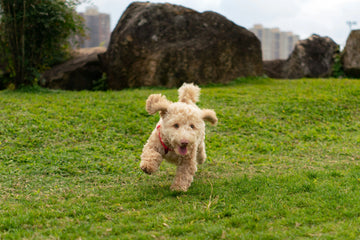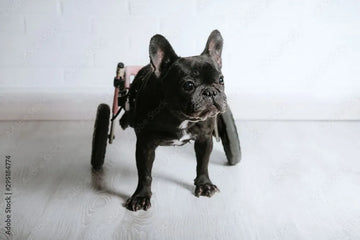During cold winter months or seasonal changes, many pet parents worry: "Could my furry friend catch a cold?" Today, let's delve into everything you need to know about dog colds to help better protect your pet's health.

Can Dogs Really Catch a Cold?
The answer is yes. Although dog colds differ from human colds in both causes and symptoms, they can indeed catch colds for various reasons.
Common Causes
Environmental factors play a significant role. Dogs can catch a cold when they can't adapt quickly enough to sudden temperature drops or dramatic weather changes. Additionally, if dogs aren't dried properly after getting caught in the rain or after bathing, this exposure to cold can lead to illness. Moreover, dogs with poor nutrition or weakened immune systems are more susceptible to respiratory viral infections.
High-Risk Groups
Among all dogs, puppies and senior dogs are most susceptible to colds due to their relatively weaker immune systems. Dogs with weak constitutions or long-term malnutrition are also more vulnerable.

How to Identify a Dog Cold?
1. Changes in Energy Level
If your usually energetic dog suddenly becomes lethargic, lying around unwilling to move, and showing obvious signs of drowsiness, these could be early signs of a cold.
2. Respiratory Symptoms
Dogs with colds typically show frequent sneezing and coughing, with clear nasal discharge. You might also hear slight respiratory sounds when they breathe.
3. Changes in Appetite
Dogs with colds often lose interest in food, sometimes even refusing their favorite treats - a situation that requires attention.
4. Abnormal Temperature
Healthy adult dogs should maintain a temperature between 37.5-38.5°C (99.5-101.3°F), while puppies range between 38.5-39°C (101.3-102.2°F). Temperatures outside these ranges might indicate fever.
5. Physical Changes
Dogs with colds may show noticeable changes. Their usually wet nose might become dry, eyes may appear bloodshot, and tear stains might be more prominent.
6. Behavioral Changes
Sick dogs typically become less active, may avoid light, and some might become either more clingy or more solitary.

How to Handle Dog Colds Scientifically?
1. Home Care Guide
Environmental Control
Create a comfortable recovery environment for your dog. Keep indoor temperatures between 20-25°C (68-77°F), avoid direct drafts, maintain proper ventilation, and provide a warm, comfortable bed.
Dietary Adjustments
Pay special attention to diet modifications. Offer warm, easily digestible foods like warm meat porridge. Consider appropriate supplements to boost immunity. Most importantly, ensure constant access to clean water.
Daily Care
Regularly wipe away nasal discharge, keep eyes clean, provide gentle massage to promote circulation, and monitor bowel movements closely.
2. Medical Care Guide
When to See a Vet
- Fever above 39.5°C (103.1°F)
- Persistent coughing for over 24 hours
- Complete food refusal for over 12 hours
- Difficulty breathing
- Extreme lethargy
- Nasal discharge changing from clear to thick or bloody
Preparation for Vet Visit
When visiting the veterinarian, prepare the following information:
- Recent eating habits
- Timeline and progression of symptoms
- Possible contact with sick dogs
- Recent notable events (rain exposure, intense exercise, etc.)

Prevention is Better Than Cure
1. Daily Preventive Measures
- Maintain appropriate indoor temperature, avoid large temperature fluctuations
- Regular ventilation for fresh air circulation
- Keep dog's coat clean and dry
- Appropriate exercise to build strength
- Regular nutritional supplements to boost immunity
2. Special Period Precautions
- Add appropriate clothing during seasonal transitions
- Dry thoroughly after exposure to rain
- Ensure complete drying after baths
- Avoid contact with sick dogs
- Timely vaccinations to build immunity barrier

FAQ
Q1: How long does a dog cold typically last?
A: Mild colds usually improve in 3-5 days and fully recover within 7-10 days. However, improper care might extend recovery to 1-2 months or develop into bronchitis or pneumonia.
Q2: Can dog colds spread to other pets?
A: Some viral colds can be contagious to other dogs. It's recommended to isolate sick dogs for observation.
Q3: Can I bathe my dog during a cold?
A: Not recommended. Avoid bathing during illness to prevent worsening symptoms. Wait until full recovery before resuming normal bathing routine.
Q4: How can I distinguish between a common cold and other illnesses?
A: Common colds typically have mild symptoms with clear nasal discharge. If you notice purulent secretions, persistent high fever, or severe coughing, it might indicate other illnesses requiring immediate veterinary attention.

While dog colds are common, careful observation, scientific prevention, and timely treatment can help our furry friends safely recover. Remember, during illness, an owner's patience and care are the best medicine. When in doubt, seeking veterinary care is always the safest choice. Let's be responsible pet parents and safeguard our furry friends' health together!





